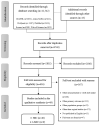Adherence to Food-Based Dietary Guidelines: A Systemic Review of High-Income and Low- and Middle-Income Countries
- PMID: 33807053
- PMCID: PMC8004702
- DOI: 10.3390/nu13031038
Adherence to Food-Based Dietary Guidelines: A Systemic Review of High-Income and Low- and Middle-Income Countries
Abstract
Research comparing the adherence to food-based dietary guidelines (FBDGs) across countries with different socio-economic status is lacking, which may be a concern for developing nutrition policies. The aim was to report on the adherence to FBDGs in high-income (HIC) and low-and-middle-income countries (LMIC). A systematic review with searches in six databases was performed up to June 2020. English language articles were included if they investigated a population of healthy children and adults (7-65 years), using an observational or experimental design evaluating adherence to national FBDGs. Findings indicate that almost 40% of populations in both HIC and LMIC do not adhere to their national FBDGs. Fruit and vegetables (FV) were most adhered to and the prevalence of adhering FV guidelines was between 7% to 67.3%. HIC have higher consumption of discretionary foods, while results were mixed for LMIC. Grains and dairy were consumed below recommendations in both HIC and LMIC. Consumption of animal proteins (>30%), particularly red meat, exceeded the recommendations. Individuals from HIC and LMIC may be falling short of at least one dietary recommendation from their country's guidelines. Future health policies, behavioral-change strategies, and dietary guidelines may consider these results in their development.
Keywords: adherence; diet intake; dietary guidelines; high-income countries; low- and middle-income countries.
Conflict of interest statement
The authors declare no conflict of interest.
Figures
References
-
- Lobstein T., Brinsden H. Obesity: Missing the 2025 Global Targets. World of Obesity; London, UK: 2020.
-
- Leme A.C., Muszynski D., Mirotta J.A., Jewell K., Caroll N., Hogan J., Yu J., Fisberg R.M., Ma D.W.L., Duncan A.M., et al. Diet quality of Canadian pre-school children at two to five years old from the Guelph Family Health Study: Family-based study. Can. J. Diet. Pract. Res. 2020 doi: 10.3148/cjdpr-2021-009. - DOI - PubMed
Publication types
MeSH terms
LinkOut - more resources
Full Text Sources
Other Literature Sources



